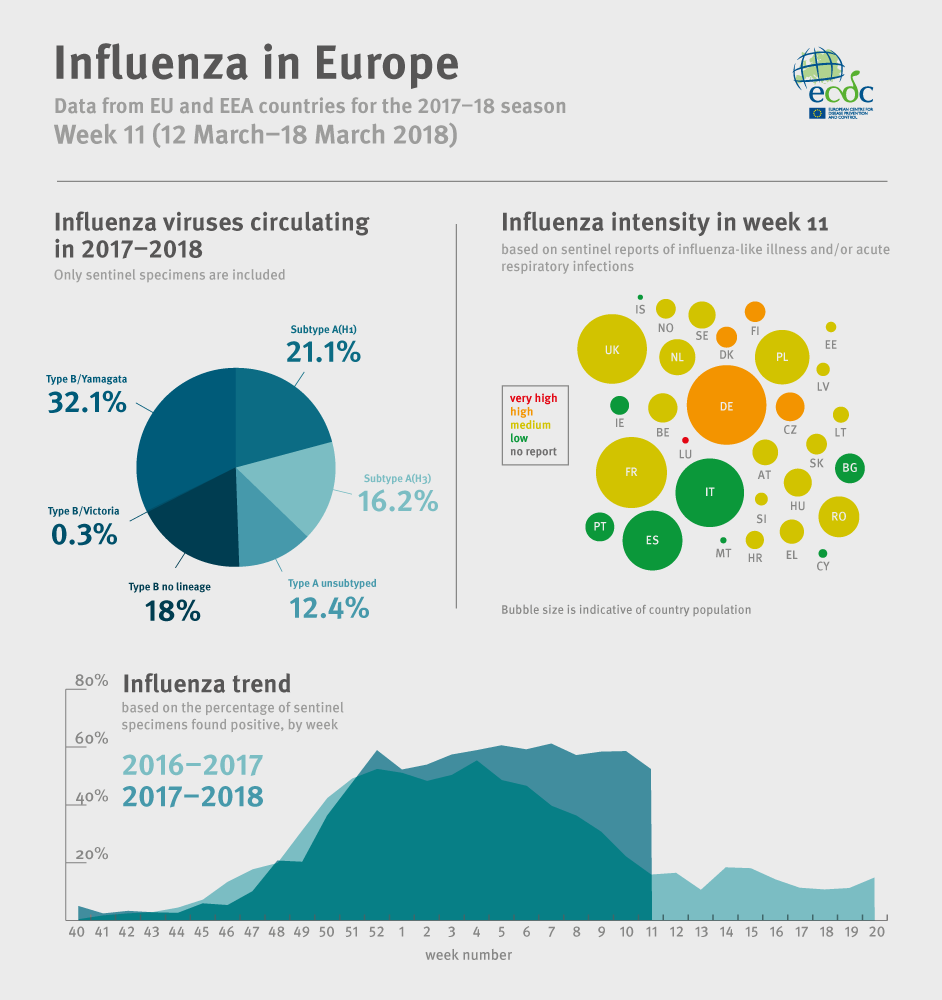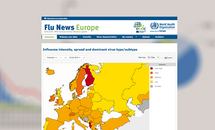Weekly influenza update, week 11, March 2018
Influenza viruses continue to circulate widely in the Region with some eastern European countries that have only recently reported increased activity, experiencing a late start to the season with increased circulation of influenza type A viruses. Similar to the previous week, 44% of the individuals sampled from primary healthcare settings tested positive for influenza viruses, despite the peak rate for the Region occurring in week 05/2018. Both influenza virus types A and B were co-circulating with the majority being type B viruses and B/Yamagata continuing to be the dominant lineage. Similar proportions of influenza type A and B viruses were reported in patients admitted to ICU, with the majority of severe cases reported this season being due to influenza type B and occurring in persons above the age of 15 years.

Download

Summary
-
Influenza viruses continue to circulate widely in the Region with some eastern European countries that have only recently reported increased activity, experiencing a late start to the season with increased circulation of influenza type A viruses.
-
Similar to the previous week, 44% of the individuals sampled from primary healthcare settings tested positive for influenza viruses, despite the peak rate for the Region occurring in week 05/2018.
-
Both influenza virus types A and B were co-circulating with the majority being type B viruses and B/Yamagata continuing to be the dominant lineage.
-
Similar proportions of influenza type A and B viruses were reported in patients admitted to ICU, with the majority of severe cases reported this season being due to influenza type B and occurring in persons above the age of 15 years.
2017/18 season overview
-
For the region overall, the majority of influenza viruses detected were type B, representing a high level of circulation of influenza B viruses compared to recent seasons. B/Yamagata lineage viruses have greatly outnumbered those of the B/Victoria lineage. Click here for more information
-
Different patterns of dominant type and A subtypes were observed between the countries of the Region, which may be due to differences in relative weights of information being derived from sentinel, non-sentinel and severe influenza case sources of information. Influenza A viruses are dominant in several eastern European countries (e.g. Russian Federation, Kazakstan). See the maps below for more information
-
Of the type A virus detections from sentinel sources, the majority of which were subtyped, A(H1N1)pdm09 viruses have outnumbered A(H3N2) viruses. In non-sentinel sources, more A(H3N2) viruses than A(H1N1)pdm09 viruses were reported. Click here for more information
- While low in number, 56% of A(H3N2) viruses belong to clade 3C.2a and 48% of B/Victoria viruses belong to a subclade of clade 1A viruses that are antigenically distinct from the current trivalent vaccine component. Click here for more information
- The majority of severe cases reported this season are due to influenza type B and occur in persons above the age of 15 years. Click here for more information
- Mortality from all causes based on pooled data from 19 EU countries and regions that reported to EuroMOMO remained elevated in some countries, while it was declining in others. Click here for more information
- Interim results from 5 European studies indicate that influenza vaccine effectiveness was estimated to be similar to that in recent years.






